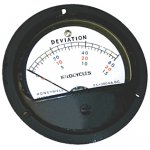Keith_J
Well-known member
- 3,657
- 1,328
- 113
- Location
- Schertz TX
Took me less than 2 weeks to get this one running. First issue was the fuel tank, cleaning+welding+POR tank sealer took care of that. Next was the injection pump control lever was frozen. Took it off the IP and cleaned it, same design of pump as a M35's LDT/LDS American Bosch BUT you have to use a mirror to see where the collar is to engage the pawl.
Lots of cosmetic paint/rust issues have been dealt with, the generator head has a fresh coat of POR while the air cleaner is stripped to the galvanized surface. Frame is stripped under the tank since leaking fuel destroyed the finish. So much for chemical agent resistant coating.
The governor was all out of adjustment. Since the frequency meter is inop, I bought a digital multimeter with frequency. Bam, it holds 60 Hz +- 0.25 Hz. Have yet to load test so the current meter function is also questionable. About the only load I can put on it is my welder, will need to double check voltage and frequency before hooking it up to 3 phase (yes, my welder will run on it).
Other issues i ran into was a balky voltage adjustment potentiometer so I tore into that, cleaning it with tuner cleaner/lube. Now it varies uniformly from 0-1000 ohms. The fuel gauge I fixed works great, 5 measured gallons brought it to 3/4 full.
I bought a good bit of clear heatshrink to cover the chipping Nylon jackets on the exposed wiring.

Lots of cosmetic paint/rust issues have been dealt with, the generator head has a fresh coat of POR while the air cleaner is stripped to the galvanized surface. Frame is stripped under the tank since leaking fuel destroyed the finish. So much for chemical agent resistant coating.
The governor was all out of adjustment. Since the frequency meter is inop, I bought a digital multimeter with frequency. Bam, it holds 60 Hz +- 0.25 Hz. Have yet to load test so the current meter function is also questionable. About the only load I can put on it is my welder, will need to double check voltage and frequency before hooking it up to 3 phase (yes, my welder will run on it).
Other issues i ran into was a balky voltage adjustment potentiometer so I tore into that, cleaning it with tuner cleaner/lube. Now it varies uniformly from 0-1000 ohms. The fuel gauge I fixed works great, 5 measured gallons brought it to 3/4 full.
I bought a good bit of clear heatshrink to cover the chipping Nylon jackets on the exposed wiring.




 That means it can probably do 230 volts in 3 phase. Which means it will also do at least 8 kW, meaning it will drive my welder up to 200 amps of output. As the duty cycle of the welder is 20% at 200 amps in stick welding mode, that means 2 minutes of welding out of every 10 minutes of clock time. The generator should easily handle that.
That means it can probably do 230 volts in 3 phase. Which means it will also do at least 8 kW, meaning it will drive my welder up to 200 amps of output. As the duty cycle of the welder is 20% at 200 amps in stick welding mode, that means 2 minutes of welding out of every 10 minutes of clock time. The generator should easily handle that.